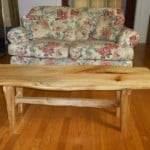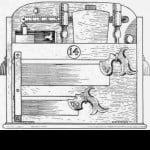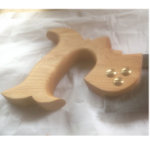My mortice (chisel) saga
Welcome! / Forums / General Woodworking Discussions / Tools and Tool Maintenance/Restoration / My mortice (chisel) saga
- This topic has 13 replies, 9 voices, and was last updated 6 years, 11 months ago by
Harvey Kimsey.
-
AuthorPosts
-
 11 July 2013 at 10:34 pm #14676
11 July 2013 at 10:34 pm #14676Hey all,
It’d been a while since I chopped mortises – I last did them on my workbench a year ago this weekend (benchaversary soon!). I figured I’d pick it up again quickly while doing the coffee table legs but made a fair few mistakes. The only ones I’m concerned about are the through tenons. Hopefully I’ll be able to get them looking more acceptable at final fitting time. The fit is good, the look less so.
My biggest problem was keeping the chisel vertical. I also got some blowout on the opposite face when cleaning up the walls as my concentration slipped, letting the chisel go the whole way through the mortice.
I did some more practice on scraps but kept suffering the same problem. I’ve been using the Narex bevel-edged chisels. I also foolishly made the mistake of getting the metric version, which won’t match my plough plane. 10mm is anything but 3/8″! Not a problem on the coffee table but may be on other projects like the cutting board.
I decided to get myself a 3/8″ mortice chisel and see if the results improved (I’ve still got the magazine rack mortices to chop). I didn’t want to buy vintage ones because I barely have enough time to do any project work, let alone another tool restoration. I could only find the Narex mortice chisels in metric, so they were out straight away. I looked at the LN ones but I couldn’t find a supplier in the UK with any of them in stock – apparently LN haven’t sent any over for ages and nobody seems to know when they’ll be back.
It was then that I remembered the Ray Iles ones mentioned in The Anarchist’s Tool Chest. I’ve spoken with Ray on the phone a couple of times when buying other tools so gave him a call and put an order in for a 3/8″ one. It arrived today and, after a quick hone, put it to use on some leftover oak.
It was a revelation. It’s heavy. Super heavy. That’ll take a bit of getting used to. The handle is oval so you instinctively hold it square. The steel is rock hard but you only need to sharpen the secondary bevel (typical on mortice chisels) so it doesn’t take long and takes a good edge. Apparently the edge lasts for an astonishingly long time as well.
I used the same technique I’d been using with the bevel-edged (Paul’s technique) and didn’t have a problem at all. I can’t say for sure whether it was the chisel or some dramatic change in my technique but my mortice was square and the walls were clean. It currently doesn’t seem to chop any slower or quicker but I’m still using the Thor hammer, which doesn’t really have the mass to hit the chisel with any huge force. I’ve laminated some maple to make a mallet (no 3″ oak left, unfortunately) and once that’s done I’ll be able to really pound on the chisel, which is probably when it’ll come into its own.
Overall, I’m over the moon with it. I’ve no doubt that it’s likely only compensating for my lack of technique and experience but I’m happy to let it do so while I improve.
If you’re in the same boat as me, getting results you’re not entirely happy with from your chopping and can afford just one mortice chisel, snag one (3/8″ will likely get used a lot) and try it out.
Another top tip: Sharpen your combination gauge pins! There’s no reason your gauge lines need to be as wide as mine were. Grrrr frustration!
Happy chopping!
George.
Narex Mortice Chisels (Imperial)
http://www.workshopheaven.com/tools/Narex_Mortice_Chisels_Imperial-8882.html
They are true Imperial, I love them and they are well priced.
Nice read, thanks for posting
 12 July 2013 at 12:18 am #14680
12 July 2013 at 12:18 am #14680Hey George,
Here is a technique helper… Take a look at the coffee table episode 1, around 22:20. He shows a jig he uses to chop a mortise that is a nominal thickness piece of hardwood, faced with a smaller size piece the same thickness as the mortise shoulders. You clamp that and your piece in the vise, and use your chisel against the jig. It keeps the mortise wall dead square to the shoulder. He uses it in episode 2 to chop the leg mortises.
I’m in a month long class with Paul right now, and used that jig all day to chop mortises. They are dead square, dead accurate, and very fast. Any of the methods show in episode 5 to cut and trim your tennons will work. I especially like to split the tennon and dial in with the router.
Attachments:
You must be logged in to view attached files.
I like the Ray Iles “pigsticker” style of mortice chisel the best. The oval handle gives you a sense of direction when holding the chisel, and the wide wide blade keeps the chisel from twisting – which seems to be the cause of a rough mortise.
I bought a vintage set of pigstickers from the UK a while back, but did not realize back then that someone (probably the seller) ground the tip of the front edge, probably in order to make them seem sharp. Now the leading edges are not perfectly flat. Argh! I have some other sash mortice chisels to use until I get a chance to lap those edges.
 13 July 2013 at 5:04 pm #14714
13 July 2013 at 5:04 pm #14714@ken I don’t know why I didn’t think to check WH. I might try a Narex one to see if the premium on the Ray Iles ones is worth it.
@woodworker435 I did think about making the jig but want to be able to get my technique to the point where I don’t need one. I’ll keep it in mind if I can’t get the freehand technique sorted quickly enough.
@rroselavy I’m certainly getting much less problems with twist with the mortice chisel! I think it’s also the other (relatively) sharp edges that help get clean walls.I’ve made my mallet now and the chisel just flies through oak and stays plumb. Love it!
George.
 13 July 2013 at 5:53 pm #14720
13 July 2013 at 5:53 pm #14720A firmer or mortise chisel will always be better than a bevel edge chisel. Also take bit more of a pounding.
They will have less likely to twist as more of the side of the chisel will register against wall of mortise.
Also flatten edges of chisel as well as flattening back to keep corners nice and crisp. This helps cut mortise as well.
I was considering buying a set of Narex mortise chisels until I heard that the chisel width tapers from the tip to the handle to provide sidewall clearance. I have been using Paul’s mortise guide and I’m worried that the sides of the mortise would be angled when the chisel is held tightly to the guide. Has anyone had experience using them with Paul’s guide?
Same as you OP, I have been using my narex bevel edge chisels to chop mortices and was also looking to get the narex mortice chisels.
Can anyone comment on reasons why you might go for imperial or metric sizes when buying?
I figured it was just a personal preference thing for the measuring system you used/preferred. But seems there might be more to it than that?
@george it has been some time since your original posting. I’m curious how things turned out with learning to chop mortises freehand. Do you feel comfortable with it now, or did you settle on using something like Paul’s jig?
@donhatch does it really taper going up to the handle, or is the taper across the blade, from bottom to top (back to front)? Many mortise chisels are tapered back to front so that they form a trapezoid in section.
Ed,
After doing some more poking around, I found out the chisels are tapered 3 degrees from back to front, as you suggested. Thanks for setting me straight. Now my question is, does the taper cause a problem if you are using Paul’s mortise jig? It seems like if you are holding the side of the chisel tight against the jig, it would then be twisted 3 degrees to the wall of your mortise. Is that such a small amount that it doesn’t matter?@donhatch , I used a tapered mortise chisel with Paul’s jig yesterday, actually. Just keep in mind that you’re using it to stay plumb, so keep the wider edge of the chisel against the guide and just use your eye to stay square across the narrow width of the mortise. That’s not a big deal. Keep in mind, though, that if you need to flip the chisel around so that the wide face is away from you, then you will see a narrow gap between the chisel and the guide facing you even though the other face is against the guide. That’s not really a problem, as you can feel the contact against the guide.
14 August 2017 at 3:26 am #314489I recall a video on YouTube of Paul chopping a mortise with a bevel edge chisel and another mortise with a mortise chisel. The result was the mortise walls were cleaner when cut with a bevel edge chisel. Why this would be I don’t know. Has anyone else seen this?
-
AuthorPosts
- You must be logged in to reply to this topic.
